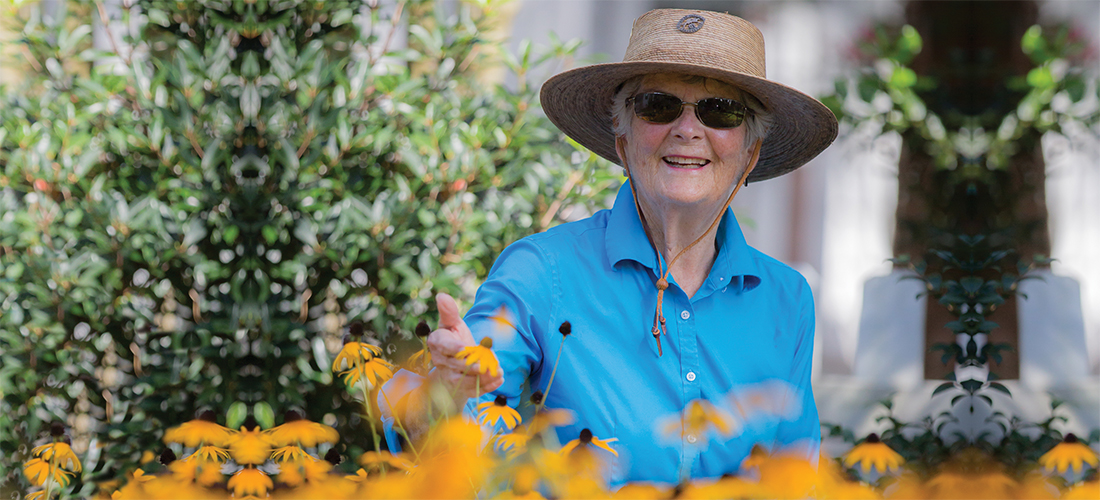
Mary Francis Tate insists that every house deserves a setting
By Deborah Salomon
photograph by Laura Gingerich
Monet used paint — Rodin, bronze. Hemingway relied on words while Dior draped taffeta. Mary Francis Tate expresses her art through trees, shrubs, flowers, stones, water and grass, since, she believes, no well-designed building, residential or commercial, looks complete without a setting.
Hardly a new idea. Peruse Versailles, Biltmore Estate and the Taj Mahal, whose gardens symbolize paradise. Fredrick Law Olmsted himself taught that landscape architecture/design “brings out the genius of a place.”
Tate’s vocational roots spring from Clarendon Gardens, the Sandhills’ own Garden of Eden; in 1945 her father, successful paper manufacturer Francis Howe, moved the family from Buffalo, New York to 25 acres with a historic home in Pinehurst. “He had the bright idea to develop a private garden, which became a public garden,” Tate says. Howe collected plants from all over the world. “I was only a little girl but I followed him around — I loved the plants.”
By the 1950s this plant paradise had become a tourist attraction second only to golf. Tate studied landscape design and horticulture at N.C. State and worked at Clarendon Gardens until it was purchased for residential development. The results made her “very sad.”
Beginning in 1972 Mary Francis and her naval officer husband, Bob Tate, were stationed in Turkey, where she met the U.S. ambassador, William Macomber Jr., and his wife, Phyllis, who hired her to redesign the embassy gardens. “Mrs. Macomber sent a handwritten note by chauffeur-driven limousine to our apartment and waited for my answer,” which impressed the neighbors. “This was a huge job, five acres, with 10 gardeners at my beck and call.” She was given carte blanche, allowing her to order seeds, bulbs and plants from Europe and elsewhere.
Once back in the Sandhills Tate established her own design business — with many visual signatures, including symmetry: “I like curves and tumbled-brick privacy walls to block unsuitable views.” Her arrangements often contain benches, statuary and water environments. She enjoys making swimming pools look like rock-rimmed ponds and transforming culverts into babbling brooks. Soil enhancement, grading, terracing, walkways, tree placement and perennials complete the package.
The Firestone and Reynolds families have been clients.
“None of my jobs look the same,” Tate says, a result of investigating not only a client’s preferences and childhood recollections (“Do they remember climbing a maple tree?”) but the interior of the house. This means no red azaleas framing the window of a room decorated in pink. And no formal Japanese garden surrounding a Charleston plantation. No idea is too far-fetched, either. Her scrapbook contains “secret” walled gardens and examples of what the British call a “folly”; she constructed what appeared to be the broken-down corner of an old building, then smothered the ruin in vines. Another time she positioned a dead pine tree to look as though it had a fallen and weathered naturally. The list of unusual elements includes a “ha-ha” — a deep trench dug between pasture and lawn to keep animals from crossing — instead of a fence to block the view.
Tate is also known for strong (and sometimes salty) opinions, namely that landscape design, trees, shrubs and plants are as important as house and furnishings, therefore deserving of generous funding. “I want people to be so excited about creating that they don’t think about the cost. Because what’s more important than having a lovely property to show off a home?”
Tate deplores contractors who think a flatbed of assorted plants from a convenient nursery constitutes landscaping. Shabby work like ignoring soil conditions or selecting plants that will outgrow their space provokes anger. “I’m heartbroken when (my projects) aren’t maintained.” Clients like Peggy Adair, who moved to CCNC in 1994, stay with Tate long term. “We worked together to give a brick ranch house more character,” Adair says. When the Adairs needed a fenced yard for their poodle, Tate softened it with boxwoods. “She moves plants around, is constantly doing something — the garden is still a work in progress.”
Well into her 70s, Tate has no plans for retirement. “I can’t wait to get up in the morning and get to work.” She still reels off Latin botanical tongue-twisters like a spelling-bee champ. She mastered computer design programs, accepts out-of-town assignments, travels to garden shows and studies how trends in architecture influence landscape design.
But this has not changed: her passion.
“I love plants,” Tate exclaims, fervently. “How can you not love them? I treat them like children. They are my world.” PS





